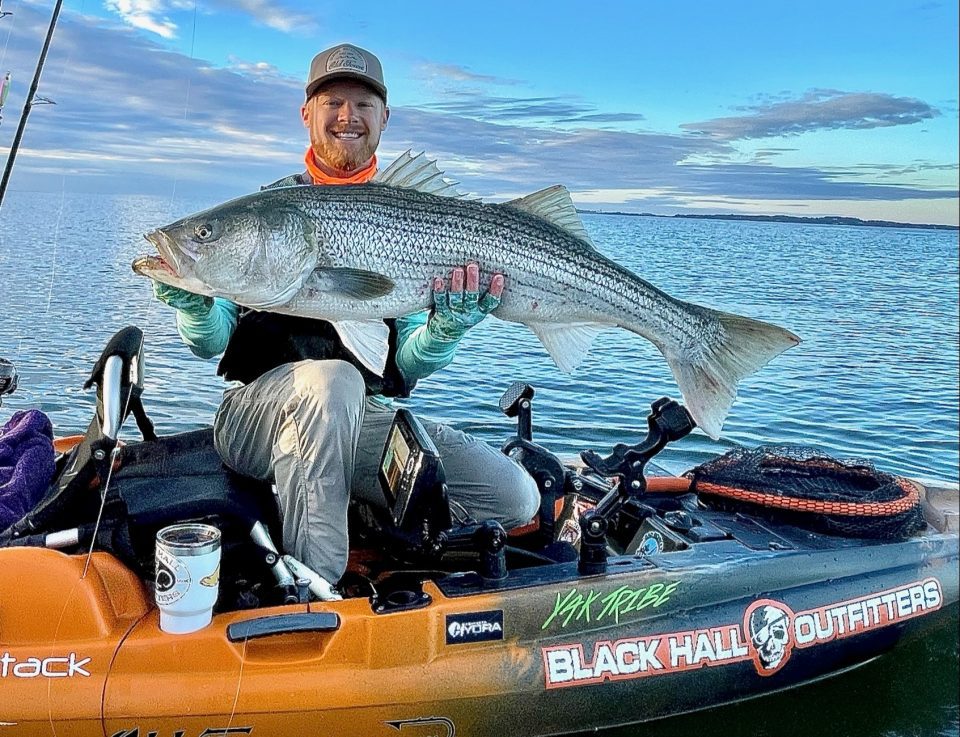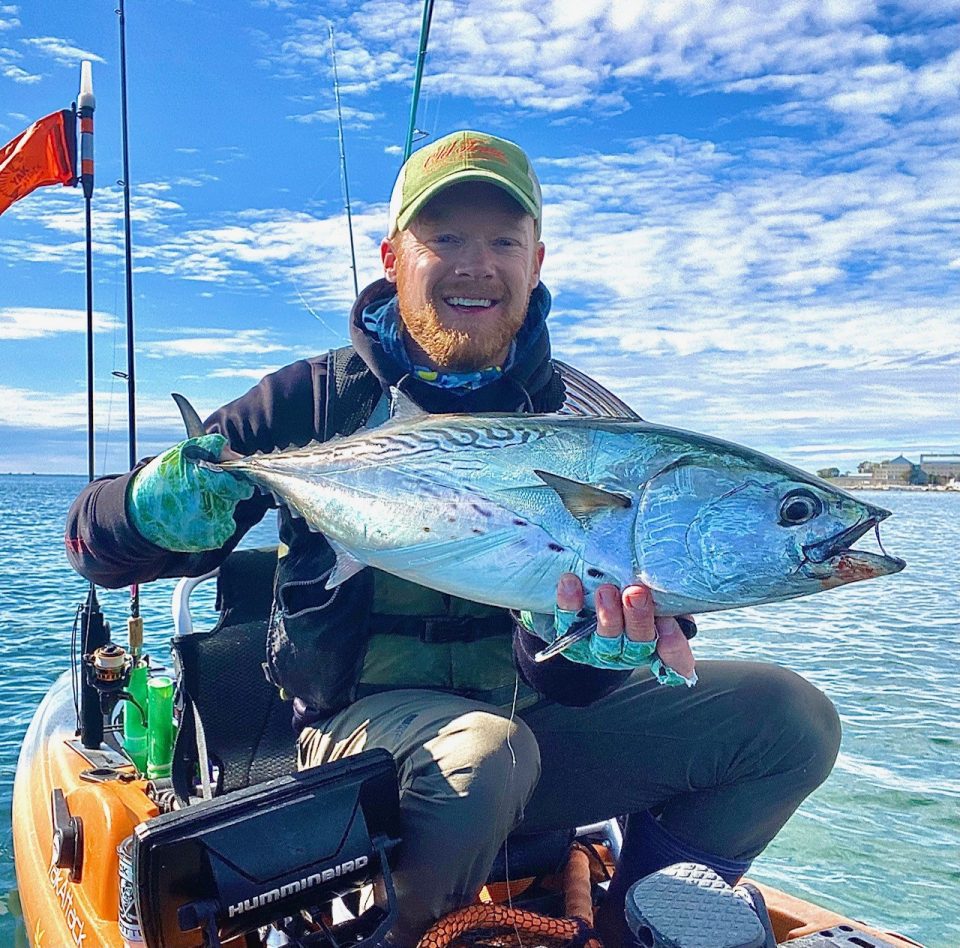Building Out Your Quiver: Rod and Reel Combos for Targeting New England Game Fish
By, Matt Stone, Scott Schneider, and Evan Kamoen Black Hall Outfitters Pro-Staff
Picking the best rod and reel combination for a given type of fishing and a particular target species can be overwhelming and stressful. Everyone has preferences that they swear by, and it’s very likely that you could do your research and make the leap to purchase a highly recommended combo only to show up to your local boat launch or jetty and have a different angler scoff and claim you’ve got it all wrong. In the end, choosing a rod and reel setup is a bit like choosing a pizza place: Even the not so great ones very likely get the job done. As long as you’re not showing up to Falmouth Harbor ready for a day of albie fishing with your trusty Finding Nemo rod, you can make it work.
Below are some of our favorite setups for targeting common game fish in most coastal New England waters. When relevant, we’ve differentiated between kayak and boat setups. Keep in mind, these are simply the recommendations of a few experienced kayak and boat fishermen and provide curious anglers a starting point. Note: if your budget is a challenge, many of these combos can work for multiple styles of fishing if desired.
Topwater Striped Bass (Boat)
The Rod: Daiwa Proteus Inshore 76MH
The Reel: Shimano Vanford 5000
A perfect do-it-all rod and reel combo for effectively chucking most topwater plugs, the Proteus series from Daiwa has a fantastic soft tip for working poppers and spooks, but the backbone is strong as steel and kicks in at just the right time when fighting big stripers. With the 5000 Vanford, Shimano has a gem of a reel. Buttery smooth drag and ball grip lets you fight fierce cow stripers with confidence.
Topwater Striped Bass (Kayak):
The Rod: Lamiglas Black Inshore 7630S (76H)
The Reel: Daiwa BGMQ 6000
This combo is a dual threat beast. The rod provides the leverage you need to both cast large, heavy plugs, and effectively fight big stripers. At times in a kayak, large stripers will tow you at will, so if you’re fishing near structure like boulders it’s imperative to use a rod strong enough to winch them away from hazards, even if they’re still towing you around while you do so! The BGMQ is strong in the drag department with 26.2 pounds max, while also providing a light frame at 15.2 ounces. You’ll be sending out a ton of casts, so a setup boasting an effective strength + weight combination is crucial.
Live Eels or Live Bait for Striped Bass:
The Rod: Shimano Trevala PX 7MH
The Reel: Daiwa Lexa TW 400P
When you’re throwing live bait for big stripers, your gear must be up for the challenge. You’ll want to come prepared and end up on the right side of a potential battle for a new PB. The Trevala PX is stiff, strong, and can put the brakes on even the biggest stripers. It pairs great with the new Daiwa Lexa TW, a T-wing assisted saltwater bait caster maxing out at 28.7 pounds of drag. The T-wing assists in preventing backlash, so when you’re sending slippery eels up into the rocks you can do so confidently.
Slow Pitch Jigging for Seabass:
The Rod: Daiwa Harrier 66MH
The Reel: Shimano Tranx 300HG
Slow pitch jigging, popularized in Japan in the early 2000’s, has taken the American saltwater scene by storm. It’s a multispecies tactic and is just flat out more fun than soaking bait rigs on the bottom. The Daiwa Harrier is built for slow-pitching, with deep rod bend and a comfortable split grip. It’s also absurdly light and packs a punch when battling feisty black seabass in both deep and shallow water. The Tranx is an incredibly popular saltwater bait caster made by Shimano. It’s also a beloved freshwater musky reel, so you can already tell it’s built for power! If you have not given slow pitch jigging a try yet, you are truly missing out, and this rod and reel combo can get you into the game with confidence.
Fluke (Boat):
The Rod: Shimano Trevala 66MH Casting
The Reel: Shimano Trinidad 14A
When fluking from a boat, you don’t have to shy away from breaking out the all-star lineup, and the Trevala + Trinidad combo is exactly that. This duo will excel when bottom fishing for nearly any species. The rubber handle of the Trinidad is grippy and well-shaped for when you’re cranking in line at 38 inches per turn, and the Trevala is a well-rounded Shimano rod capable of dealing with all of your fluke fishing rigs. The length is suggested at 6’ 6” in order to maximize power and leverage when setting the hook on bottom-dwelling fluke. This combo will serve you well and get some compliments in the process.
Fluke (Kayak):
The Rod: Daiwa Saltist Inshore 7H
The Reel: Tsunami Forged 12
In a kayak, we like to add some length and strength to our rod. The thinking here is that empirically we’ve learned being lower in a kayak means we lose a bit of leverage and power with a shorter rod, hence the change from a 66MH when fluking from a boat to a 7H when fluking from a kayak. The Saltist has a great butt-end grip, is lightweight but strong, and can handle heavy fluking gear. With the Forged 12, you’re getting a strong reel with a max drag of 30 pounds and a nice price point. The Tsunami Forged series is very popular for targeting a variety of bottom species, and the 12 fits just right for fluke.
Tautog with Jigs (Boat):
The Rod: Tsunami Trophy 7H
The Reel: Tsunami Evict 3000
The Trophy series from Tsunami is an affordable, durable line of rods, and a 7H is great for doing battle with tautog. A compact, powerful rod ensures a strong hook set, and it’s got the sensitivity in the tip to pick up on the sometimes-soft bite of a keeper tog. Pairing with the Evict 3000 may raise an eyebrow since it’s a spinning reel, but the Evict was built by Tsunami for bottom-fishing, and its internals manifest that claim. This setup is cost effective, battle-tested, and makes fighting smaller tog fun while giving you the confidence to land a double-digit day-maker.
Tautog with Jigs (Kayak):
The Rod: Tsunami Trophy 76XH
The Reel: Daiwa Lexa TW
There’s nothing quite like targeting the bullheaded tautog from a kayak. These fish, a fall specialty from Atlantic City up to P-town, pack a punch, and their natural habitat consists of boulders, wrecks, and pilings. You’ll need to get a hook into them, and then get them out before they shred your line on the nearest barnacle-crusted rock. A 7’6” XH Tsunami Trophy can do just that, while ensuring you get a good hook into the tog’s leathery lips. Again, leverage is key, so it’s recommended that kayak anglers use a longer rod. The Daiwa Lexa is suggested here because togging can be cold, dreary business and often comes paired with the slime of crab guts and frozen fingers, so you’ll want a no-nonsense reel that you can count on.
False Albacore and Bonito:
The Rod: Tsunami Carbon Shield II 76M
The Reel: Shimano Stradic 3000
Originally designed for reds and specks in the Gulf of Mexico, the Carbon Shield II became a beloved rod very quickly as its reach expanded north. When targeting torpedo-quick albies and bonito, you’ll want something that can whip a light soft plastic or metal jig as far as humanly possible, and the medium strength Carbon Shield II does just that. These fish can flat out fly, and since you’ll often be using leader in the 12-15lb range, a smooth drag is absolutely imperative to ensure you’re not snapping off when they make ripping runs. The Stradic 3000 is light, durable, and can handle all the above, so that when those slashing splashes boil and you lock into a speedster, you’ll come out on top.
And there we are: A handful of rod and reel combos, battle-tested, angler-approved, and geared toward specific New England-based gamefish. It’s all about dialing in your equipment and honing in on what works best for you as an angler. Good luck and tight lines!

